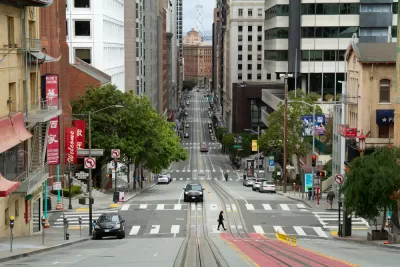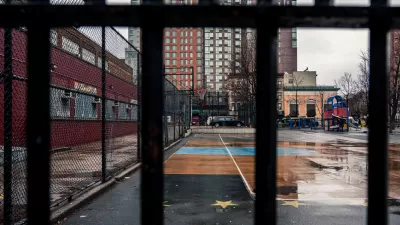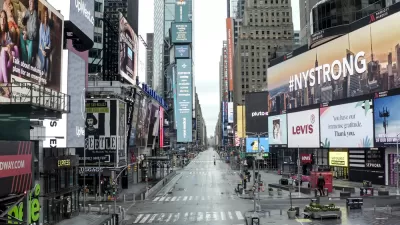Over the past year, there's been a mass exodus out of major urban areas. In states like New York, Illinois, and California, more than 59% of migration was outbound.

For much of modern history, workers have flooded to cities in search of new opportunities. Places like New York City and Los Angeles have become hubs of innovation in the process, attracting even more droves of skilled workers. The COVID-19 pandemic might upend that trend.
Over the past year, there’s been a mass exodus out of major urban areas. In states like New York, Illinois, and California, more than 59% of migration was outbound. In contrast, the leading states for inbound migration were more rural areas like Idaho, South Carolina, and Oregon.
As more people continue to move away from America's megacities, they take high-skilled jobs with them. Urban centers that were once hotspots for these workers may struggle to retain them in the coming years.
Why Jobs Are Moving Away
People have been slowly trickling out of many cities for some time now, but the pandemic accelerated the trend. Almost overnight, crowded areas became a health crisis, providing some residents with the last bit of convincing they needed to move. As the pandemic fades, those ricks will be less of an issue, but other related factors will linger.
One study revealed that affordable housing was a deciding factor for 42% of people who moved in 2020. Similarly, 48% said that their move was the result of income loss. High demand has driven up the cost of living in large cities for years, and the financial impacts of COVID-19 made them unaffordable for many residents.
The remote work revolution has also played a substantial role in this trend. More Americans than ever work from home now, and many will continue to do so after the pandemic. Now that many skilled workers can perform their duties from anywhere, they’ll choose to do so somewhere cheaper.
As these trends continue, more skilled workers will leave urban areas. Still, cities can take action to retain or draw new workers in. Here’s how.
Expand Affordable Housing
These mass exoduses wouldn’t happen at this scale if housing in cities was more affordable. Most of the states seeing the most inbound migration are also the cheapest states to live in, concentrated mainly in the South or West. When people can work from anywhere, why wouldn't they work where it's more affordable?
Zoning laws and land-use restrictions can make it challenging to provide low-income housing in bigger cities. Still, a focus on cost-effective construction methods or refurbishing older, cheaper infrastructure can help minimize costs. If cities can find a way to keep rent low, more skilled workers may want to stay.
Over time, the cost of housing in these areas will go down naturally. As current residents leave the city, demand will drop, lowering property values and, consequently, costs. These lower prices will then attract new residents, although this shift will take time.
Appeal to New Demographics
Cities may be unable to retain all of their current skilled workers, but they can attract new ones to fill the gap. To succeed in attracting new workers, cities need to recognize how this migration is emblematic of a broader cultural shift. The people these areas once attracted may no longer be interested, so they should instead target new demographics.
Millennials account for many of the people leaving cities as they start to focus on raising families, not just their professional development. Gen Z is starting to take their place as the young, enthusiastic new members of the workforce. Keeping this younger generation in mind when designing new infrastructure or advertising can help bring in more workers.
Environmentally friendly practices and cutting-edge technology will help appeal to this new demographic. If cities can become greener and smarter, more skilled workers will want to be a part of their culture.
Cultivate Local Talent
Not all new skilled workers will come from outside a city. Another way to mitigate the impact of this exodus is to make skilled workers out of current residents. If cities can cultivate local talent within their limits, they can fill gaps quicker.
Encouraging companies within the city to adopt new, more streamlined training processes can help here. Virtual training, for example, can cut site training time by 50% and get new recruits working weeks earlier. These digital options also minimize the stagnant period between jobs, which is helpful for applicants living in an expensive area.
Public resources helping young residents find and pursue skilled careers can also help cultivate local talent. People won't look for jobs they don't know about. Fostering a better support network will help residents find skilled jobs they’re interested in and gain the tools they need to perform them.
Invest in Cultural and Social Amenities
Finances aren't the only driving factor in these migrations. A lack of affordability may drive workers away initially, but one of the primary draws of a city is its rich cultural and social atmosphere. Investing in this side of city life can help retain workers and draw more in from other areas.
The pandemic may have started the remote work revolution, but it’s also instilled a longing for social activity in people. A survey in the UK found that 66% of people miss socializing with family and friends and 38% miss going to restaurants and bars. Similarly, a survey of U.S. workers found that 73% miss socializing with colleagues in-person.
Since people miss these activities so much, cities may have an advantage after the pandemic. More restaurants, bars, and other social amenities could attract workers who feel isolated after the past year. If cities invest in maintaining and expanding these cultural centers, workers won’t be as eager to leave.
America's Megacities Are on the Brink of Change
The past year will likely leave lasting social and cultural changes in the workforce. The role and residential makeup of cities will shift as a result. Cities that can adapt to these trends will be able to retain the skilled workforce that brought them to where they are today.
The transition ahead will likely be challenging, even for cities that can adapt to attract new workers. Population and job losses are all but inevitable in the short term, but they'll also likely recover eventually. Cities are changing, but the pandemic won’t be their end.

Planetizen Federal Action Tracker
A weekly monitor of how Trump’s orders and actions are impacting planners and planning in America.

Map: Where Senate Republicans Want to Sell Your Public Lands
For public land advocates, the Senate Republicans’ proposal to sell millions of acres of public land in the West is “the biggest fight of their careers.”

Restaurant Patios Were a Pandemic Win — Why Were They so Hard to Keep?
Social distancing requirements and changes in travel patterns prompted cities to pilot new uses for street and sidewalk space. Then it got complicated.

Albuquerque Route 66 Motels Become Affordable Housing
A $4 million city fund is incentivizing developers to breathe new life into derelict midcentury motels.

DC Area County Eliminates Bus Fares
Montgomery County joins a growing trend of making transit free.

Platform Pilsner: Vancouver Transit Agency Releases... a Beer?
TransLink will receive a portion of every sale of the four-pack.
Urban Design for Planners 1: Software Tools
This six-course series explores essential urban design concepts using open source software and equips planners with the tools they need to participate fully in the urban design process.
Planning for Universal Design
Learn the tools for implementing Universal Design in planning regulations.
Heyer Gruel & Associates PA
JM Goldson LLC
Custer County Colorado
City of Camden Redevelopment Agency
City of Astoria
Transportation Research & Education Center (TREC) at Portland State University
Camden Redevelopment Agency
City of Claremont
Municipality of Princeton (NJ)






























